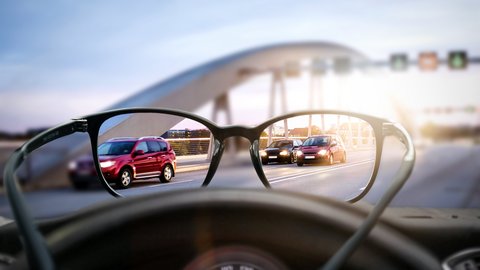Special features of the eye test
Color blindness and the eye test for trucks

Color blindness
Traffic lights are an important part of road traffic in order to avoid chaos and ensure safety. Therefore, in addition to visual acuity, the correct differentiation of colours is also relevant, even if a road user knows, of course, that the colour red is at the top of a traffic light.
Many mistakenly understand color blindness to be a red-green weakness. That's not quite right. Here one has to differentiate between colour weakness or colour vision defects. A distinction is made between red, green and blue weakness/blindness. As the name suggests, a red-green weakness is not a total failure, but merely a deficit.
The specific color blindness, i.e. the inability to recognize colors, only occurs very rarely. If you notice any limitations of this kind in yourself, here comes the good news. The colour vision test is often performed together with a visual acuity test. If it turns out that you are affected by a colour weakness, you do not have to worry per se about obtaining your driving licence. Actual colour blindness, on the other hand, is often associated with visual impairment, which must then be corrected with visual aids. It should be noted for a driving licence of categories C and D that an expert opinion for the eye test is mandatory from the ophthalmologist, as only he can determine reliable values.
The Ishihara Color Test
The test, developed in 1917 by the Japanese ophthalmologist who gave it its name, can be found quickly and easily on the Internet and carried out for free. This is how the Ishihara color test works:
- Round circles consisting of numerous colour circles of different sizes are displayed on various panels.
- In the middle of each circle is a number or letter made of colorful circles.
- People who suffer from colour weakness have great difficulty reading these signs.
Important for you:
If you are found to be colour-blind, this is only relevant if you wish to obtain a category C or D driving licence.

The eye test for the truck driving licence
Just as with the category B driving licence, the obligation to submit an eye test applies here as well. However, the regulations are stricter than for a normal driving license. A simple eye test at the optician is no longer sufficient. For the driving licence of the categories C, C1, CE, C1E an eye test with an ophthalmologist is compellingly prescribed, since this is somewhat more extensive. In addition to a classic vision test, the visual field, spatial vision, eye mobility, ability to see at dusk and colour blindness are also tested. Only the ophthalmologist is able to determine a reliable value in this respect. In the case of red weakness or red blindness with an anomaly quotient of less than 0.5, it is necessary to inform the person concerned about the possible danger, but this does not preclude driving licence training.
Important for you:
If all the tests are positive, you get the certificate and are allowed to take your driving license. Of course, visual impairments can also be compensated by glasses or contact lenses.


Find your driving school
Whether short-sighted, far-sighted or colour-blind - our search gives you a clear overview of driving schools in your area. Find your driving school and find out about the eye test there as well.